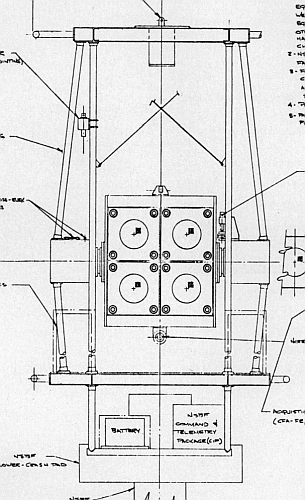Purpose of the flight and payload description
EXITE was the acronym for Energetic X-ray Imaging Telescope Experiment an instrument developed by the Harvard-Smithsonian Center for Astrophysics with the primary goal of conducting balloon-borne imaging and spectral studies of cosmic x-ray sources in the energy range of 20-300 keV. It was designed to achieve, for the first time, arcminute-level imaging of hard x-ray sources from a high-altitude platform. The instrument was a simplified version of a telescope initially proposed for satellite use (XTE) and adapted for balloon deployment to accelerate scientific return and reduce development complexity.
In the image at left we can see an scheme of the instrument and the gondola (click to enlarge). The primary detector was a NaI(Tl) scintillator, 34.5 cm in diameter and 6.4 mm thick, optically coupled to a Thomson CSF THX463 diode image intensifier tube with 17:1 electrostatic reduction optics and a fast phosphor output. A second image intensifier (THX1308) coupled to a silicon PIN-diode readout completed the imaging chain. This configuration provided spatial resolution of 3-10 mm over the energy range, enabling source imaging with an angular resolution of 22 arcminutes and positional accuracy of under 2 arcminutes. The scintillation crystal was sealed behind a 10 mil aluminum window, and x-rays had to pass through atmospheric, structural, and shielding materials before detection.
A coded aperture mask composed of a 4x4 matrix of 13x11-element Uniformly Redundant Arrays (URAs) was mounted above the detector. The mask design optimized imaging by matching the spatial resolution and field of view constraints, set to a 3.4° FWHM by the collimator, ensuring minimal background and image overlap. The collimator consisted of two crossed one-dimensional arrays constructed from lead, copper, and steel slats that enforced parallelism and maintained optical alignment.
The entire detector was enclosed in a cylindrical aluminum pressure vessel filled with dry nitrogen to stabilize internal pressure and temperature. The vessel also housed the active anti-coincidence shield made of plastic scintillators (NE-102), 0.5 inches thick on the sides and back, and 2 mm on top. These plastic shields, combined with a graded passive shield of 2 mm lead, 1 mm tin, and 1 mm copper, surrounded the detector to minimize background from cosmic rays and atmospheric gamma rays. Readout for the shields was accomplished via photomultiplier tubes (PMTs), carefully positioned for uniform light collection.
Event processing used fast pulses proportional to the charge collected on the diode sides. Events were validated within programmable energy windows and vetoed if coincident with shield signals. The system processed and digitized valid events within ~60 microseconds, buffered in a 256-word FIFO memory. Science and housekeeping data were transmitted via an 80 kbps telemetry link, with full spectral and millisecond timing capabilities up to 103 counts/sec.
Mechanically, the detector was mounted to the gondola via a shock-isolated frame that mitigated landing and parachute deployment stresses. The gondola itself was engineered for arcminute pointing stability, using an alt-azimuth configuration. Azimuth control was enhanced with a reaction wheel, necessary for the desired 0.5-1 arcminute pointing accuracy. This precision exceeded the detector's resolution needs at the time but allowed for future upgrades and reduced the need for data post-processing corrections.
The gondola was scalable, capable of carrying up to four EXITE modules, potentially increasing imaging area to nearly 2000 cm².
Details of the balloon flight
Balloon launched on: 5/17/1988 at 21:05 utc
Launch site: Australian Balloon Launching Station, Alice Springs, Australia
Balloon launched by: National Scientific Balloon Facility (NSBF)
Balloon manufacturer/size/composition: Zero Pressure Balloon N26-8/8/8/8T-23.30
Balloon serial number: R 23.30-3-114
Flight identification number: 251N
End of flight (L for landing time, W for last contact, otherwise termination time): 5/18/1988 at 8:43 utc
Landing site: 121 miles WNW of Longbeach, New South Wales, Australia
The main objective of the flight was to observe the supernova SN1987A. A balloon tape insulation problem, however, prevented normal telescope pointing on the first flight so no data on SN1987A or other targets were obtained.
External references
- Hard X-ray arcmin imaging with the EXITE telescope Revista Mexicana de Astronomia y Astrofisica, Vol. 21, p. 633 - 637
- Development of an Energetic X-Ray Imaging Telescope Experiment (EXITE) and Associated Balloon Gondola System Final Report; 1 Apr. 1984 - 31 Dec. 1997
- EXITE/IPC observations of SN1987A and southern targets Final Report. Harvard Coll. Observatory, Cambridge, MA.(1991)
- Recent results in the NASA research balloon program 27th Aerospace Sciences Meeting, 1989
186If you consider this website interesting or useful, you can help me to keep it up and running with a small donation to cover the operational costs. Just the equivalent of the price of a cup of coffee helps a lot.


